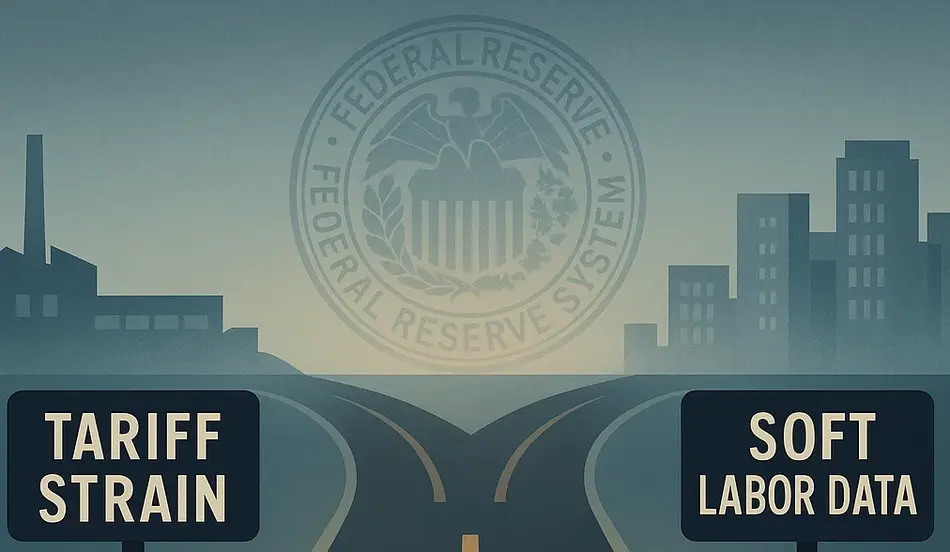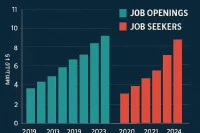The July jobs report, coupled with downward revisions from previous months, has reignited the debate over whether President Donald Trump’s trade policies are beginning to weigh more heavily on the U.S. economy. Economists have warned for months that tariffs on imported goods would slow growth, weaken hiring, and undermine investment. Trump has consistently rejected those warnings, arguing that tariffs are strengthening America’s bargaining position with foreign governments while protecting U.S. industries.
Yet the latest numbers may be giving added weight to the critics.
Yahoo Finance senior columnist Rick Newman put it bluntly in a recent segment: “This is exactly what you would expect to happen when you put tariffs on $3 trillion worth of imports. It makes them more expensive, spending goes down, investment goes down, hiring goes down.”
The data now paints a mixed, but concerning, picture.
The Numbers: Weak Jobs and Downward Revisions
July’s labor report showed a striking slowdown in hiring. Job gains were far below expectations, and revisions to prior months wiped away more growth than analysts had anticipated. Job creation is running well below last year’s pace, a significant shift in an economy that had previously been posting steady, robust gains.
In July, the economy added far fewer jobs than economists projected. Meanwhile, revisions to May and June data erased more than 250,000 jobs from the record. That kind of downward adjustment signals that the earlier reports overstated the strength of the labor market.
“The uncertainty premium is showing up,” Newman said. “Companies are just sitting tight. That’s what happens when businesses don’t know what policy will look like tomorrow.”
The warning is clear: if hiring stalls, consumer confidence—already fragile—may weaken as well, undermining one of the strongest supports of U.S. growth in recent years.
Lead With Confidence—Hire Today
Even as labor reports show weakness and revisions spark uncertainty, forward-thinking companies continue to hire. Post your job on WhatJobs and connect with qualified candidates ready to bring stability and growth to your organization.
Post a Job Now →Tariffs and Uncertainty
Economists emphasize that the tariffs themselves aren’t the only problem—it’s the unpredictability surrounding them.
Since 2018, the Trump administration has levied tariffs on steel, aluminum, and hundreds of billions of dollars’ worth of Chinese goods. In retaliation, U.S. exports have faced higher barriers abroad. More recently, the administration expanded its tariff regime to cover nearly $3 trillion in imports.
This stop-and-go policy approach has left companies unsure how to plan. Will tariffs rise again next month? Will exemptions be granted? Could entire product categories suddenly be subject to new taxes?
The uncertainty has become a tax in itself, slowing hiring and delaying investment. Businesses are reluctant to commit to new projects when the costs of materials, equipment, and exports could shift overnight.
Trump Fires the Messenger
The president’s reaction to the disappointing jobs report has drawn as much attention as the data itself. In a move that surprised economists and political observers, Trump abruptly fired the commissioner of the Bureau of Labor Statistics (BLS), the federal agency responsible for producing the jobs report.
Critics accused Trump of “shooting the messenger.” The problem, they argue, lies not with the integrity of the data but with the policies creating economic headwinds.
“This is not about the numbers being wrong,” Newman argued. “The problem is the policy.”
By undermining trust in statistical agencies, economists warn, the administration risks politicizing objective data. Reliable government statistics are essential for businesses, investors, and policymakers to make decisions.
Trump’s Push for Rate Cuts
Following the jobs report, Trump quickly took to social media to demand that the Federal Reserve cut interest rates—and fast. He called for sweeping, immediate reductions, reportedly urging a cut of three full percentage points.
Markets, however, expect something more modest. Traders using the CME FedWatch tool now place the odds of a September rate cut at more than 80%. Most economists anticipate a quarter-point reduction, with a few suggesting the Fed might consider a half-point cut if weakness persists.
But an aggressive cut of three percentage points, as Trump has requested, would be unprecedented outside of a severe crisis. Fed officials remain cautious, signaling they will act to support growth but not in a way that looks panicked.
“The Fed is not going to do what Trump wants,” Newman said. “They might move a little faster if the data worsens, but we’re not looking at a financial meltdown.”
Is a Recession Looming?
Despite the gloomy tone of the July jobs data, most analysts are not forecasting an imminent recession. Newman pointed to prediction markets that put the odds of a downturn at less than 20%. That’s a sharp decline from April, when recession fears peaked at around 67% as tariffs escalated.
Instead, economists describe the current moment as a “soft patch.” Growth is slowing, hiring is weaker, and manufacturing is shrinking, but consumer spending and business confidence have not collapsed.
GDP growth for the first half of the year showed clear signs of cooling, but still managed to remain in positive territory. That suggests the economy is downshifting rather than slamming on the brakes.
“We’re not seeing panic,” Newman noted. “It’s a slowdown, not a crash.”
The Manufacturing Slump
While the broader labor market has shown resilience, manufacturing tells a different story.
Factories have been hit hardest by tariffs, which increase input costs and reduce export demand. Manufacturing employment has shrunk in recent months, with July marking another decline. Over the past six months, the sector has shed tens of thousands of jobs.
Manufacturers report higher costs for metals, machinery, and electronics components. Meanwhile, retaliatory tariffs have curbed overseas demand for U.S. products, from soybeans to industrial equipment.
For communities dependent on manufacturing, the slowdown is painful. Even if the broader economy avoids a recession, the sector may be heading for a prolonged downturn.
Markets Brace for the Fed
Financial markets responded to the weak jobs data with a rally in bond prices, sending yields lower. The 10-year Treasury yield fell to around 4.25%, signaling investor expectations for Fed easing.
Equities initially wobbled but recovered as traders bet that rate cuts would cushion the slowdown. The odds now strongly favor Fed action at the next meeting.
The question is how aggressive policymakers will be. A modest cut could reassure markets, but a bolder move might risk signaling panic.
Stay Ahead of Market Shifts—Hire With Confidence
As markets brace for Fed decisions and rate changes, one investment always delivers—your people. Post your job on WhatJobs and secure top talent ready to help your business adapt to economic uncertainty.
Post a Job Now →Trump’s Gamble
Trump has staked much of his economic narrative on the success of his trade strategy. He has argued that tariffs will force trading partners, especially China, to make concessions while protecting U.S. industries and jobs.
But the growing evidence of slower hiring and weaker investment raises doubts about whether the gamble is paying off.
The president’s critics see the jobs report as confirmation of their warnings. Supporters argue that temporary pain is worth the long-term benefits of reshaping global trade rules.
What’s clear is that the political stakes are high. With a re-election campaign looming, Trump is eager to show that his policies are delivering results. Weak job numbers and slowing growth could undermine that message.
Looking Ahead
The next few months will be crucial. Key indicators to watch include:
- Inflation data, due next week, which will show whether prices are rising as tariffs feed through to consumers.
- The Fed’s policy meeting, where interest rate cuts could provide short-term relief.
- Manufacturing surveys, to see whether the sector’s slump deepens.
- Consumer spending data, the backbone of the U.S. economy.
If job growth continues to weaken, recession risks could rise. For now, economists expect slower growth rather than outright contraction—but much depends on the course of trade policy and the Fed’s response.
FAQs
1. Why are tariffs hurting job growth?
Tariffs raise the cost of imported goods, which makes products more expensive for businesses and consumers. Higher costs reduce spending and investment, leading companies to slow hiring or cut jobs.
2. Is the U.S. economy headed for a recession?
Not immediately. Most analysts see a slowdown or “soft patch” rather than a full-blown recession. Consumer spending remains strong, but risks are rising if trade tensions persist.
3. Can the Federal Reserve offset the impact of trade wars?
The Fed can cut interest rates to support borrowing and spending. However, monetary policy cannot fully counteract the uncertainty created by tariffs, which influence business decisions in ways rate cuts cannot fix.
4. Why did Trump fire the Bureau of Labor Statistics commissioner?
Trump reportedly dismissed the commissioner after the disappointing jobs report. Critics say the move was symbolic—blaming the data rather than addressing the underlying policies contributing to weaker job growth.




